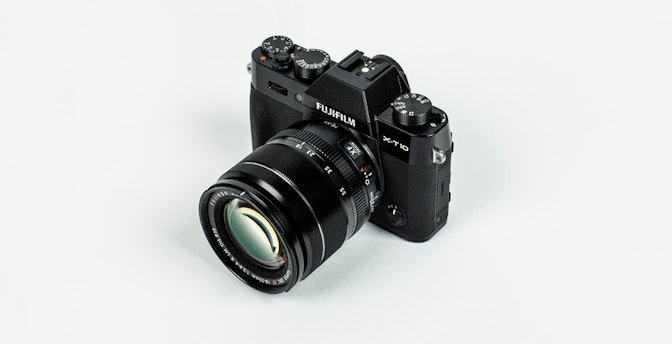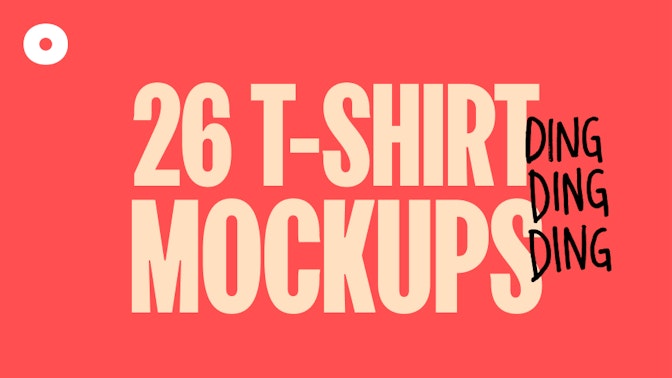With 2020 already well underway, it’s time to start thinking about all of the fantastic campaigns you can run throughout the year to get customers spending.
When you think of days when consumers are prepared to buy, your mind probably jumps to the big end-of-year holidays. But why wait until November to start all your big campaigns when you have so many other days you could capitalize on throughout the year.
To get your 2020 marketing calendar started, we’ve put together a massive list of days and events that you could use for your store and get those sales happening. And, we’ve even included a downloadable calendar at the bottom of this article that will help you keep track of your dates.
Post Contents

Don’t wait for someone else to do it. Hire yourself and start calling the shots.
Get Started FreeSpending Holidays
We’re going to ease into things with a bunch of holidays that you should already have on your calendar – the big ones that are proven to generate sales. Although these shopping holidays are when most online stores run sales, because there’s so much money being spent during this time, there’s no reason they can’t be profitable for your store as well.
Black Friday and Cyber Monday
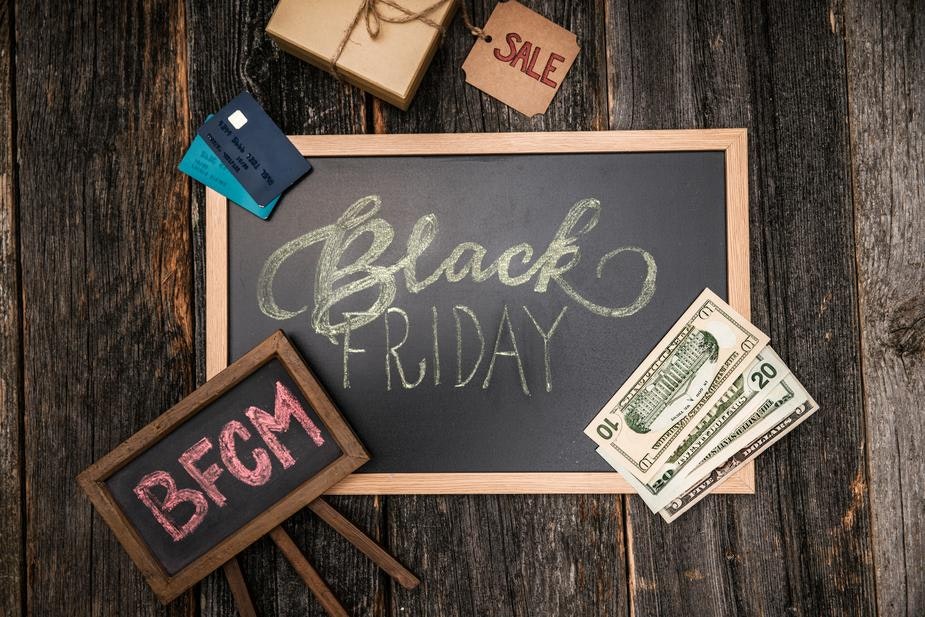
These two days bookend a massive weekend for commerce – and ecommerce in particular. In the US alone, shoppers spent over $7.4 billion online during Black Friday 2019 and went on to spend $9.4 billion on Cyber Monday. With that much cash changing hands, you’d be silly for not planning for a BFCM sale. This year Black Friday will be on November 27 and Cyber Monday on November 30.
Singles’ Day
Celebrated on November 11, Singles’ Day is an unofficial Chinese holiday for single people – but it has also become the biggest day for shipping in the world. In 2019 shoppers spent over $30 billion on Singles’ Day, and due to its popularity, Singles’ Day has become more internationally recognized in recent years – much like Black Friday. Because of this, it could be well worth jumping on the trend and adding Singles’ Day to your calendar.
Halloween and Valentine’s Day
These are two holidays that people love to spend on, so if you sell items in a complementary niche – think along the lines of decorations, costumes, supplies, and gifts – these are two days that should certainly go on your calendar.
However, bear in mind that these are holidays can also be regional. While Halloween is enormous in the United States and Canada, it’s not as popular in Australia and New Zealand. Researching on local holidays will help you see where campaigns might have more impact. For example, for Commonwealth countries, December 26 – or Boxing Day – is a big shopping day. And, in Australia, June 30 is also a big shopping day, as it’s the end of the financial year.
Weird Days and Months
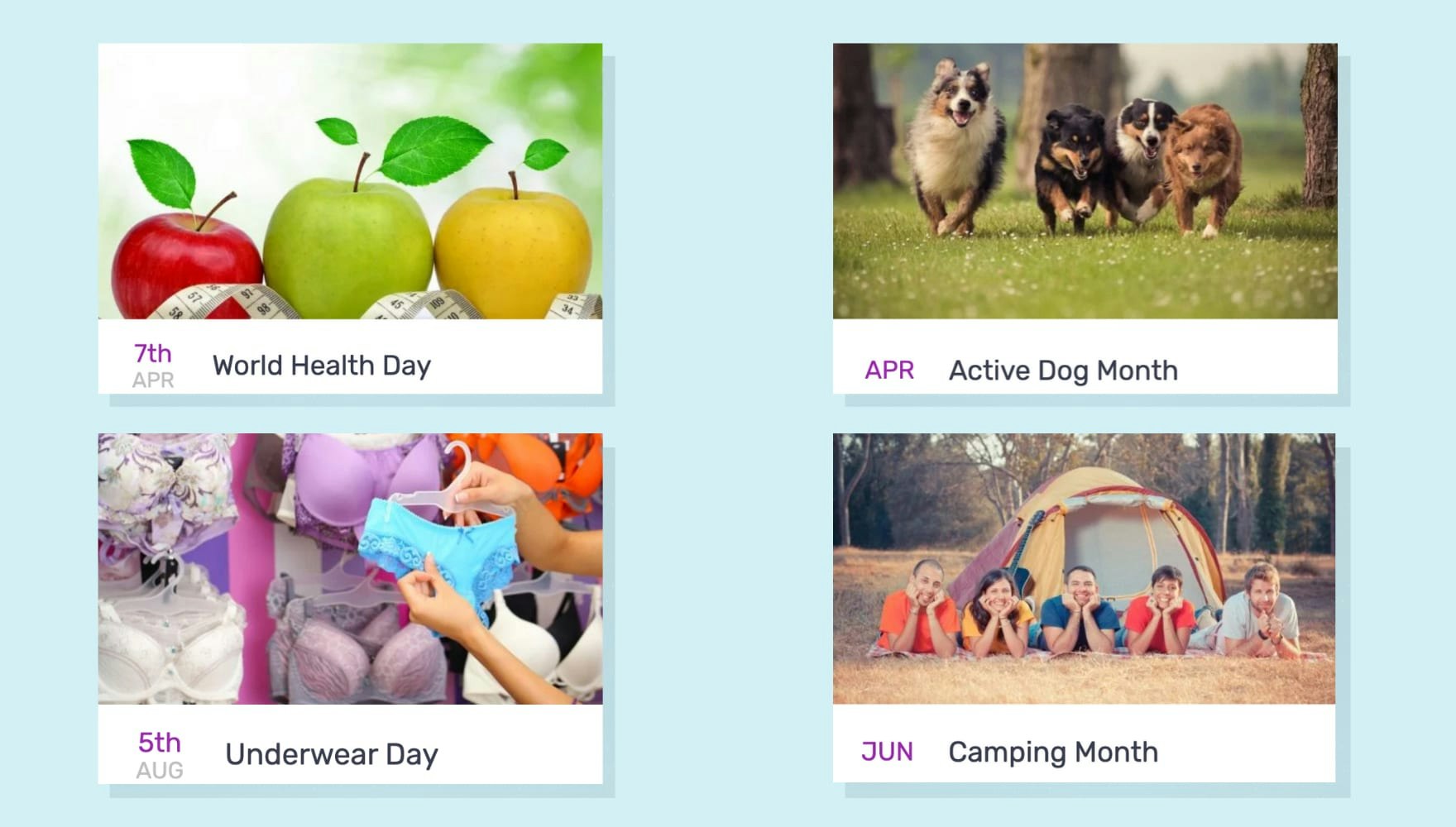
Did you know that January is Get Organized Month? Or that February 20 is Love Your Pet Day? What about International Plant Appreciation Day on April 13?
If it seems like there’s a day or month for everything, it might be because there is.
With so many fun, weird, and wacky dates, there are bound to be a few you could use as the basis for an excellent campaign for your products or store.
For example, if you’re in the pet niche and selling products for dogs, you could run sales on March 23 for National Puppy Day. Or if you’re in the jewelry niche, Jewel Day on March 13 is for you.
Although you can only use these campaigns for a short amount of time, tying your product to a relevant day will add urgency, stop potential customers in their tracks, and ideally lead to impulse purchases.
Websites such as Holiday Insights and Days of the Year will help you find the perfect day or month for your campaign, and from there, you only need to write some snappy ad copy that will entice buyers to celebrate with a purchase from your store.
And if you can’t find a day that suits your store or products? Well, you could always invent your own.
Back in 2005, UK holiday company Sky Travel sent a press release designating the third Monday of January to be Blue Monday – a.k.a the most depressing day of the year. While they claimed academics calculated the day by taking into account Northern hemisphere weather conditions, in reality, it was all pseudoscience. Despite this, 15 years later, Blue Monday is still an annual event in the UK, so why not take a chance by creating a store-relevant day?
Astrological Signs
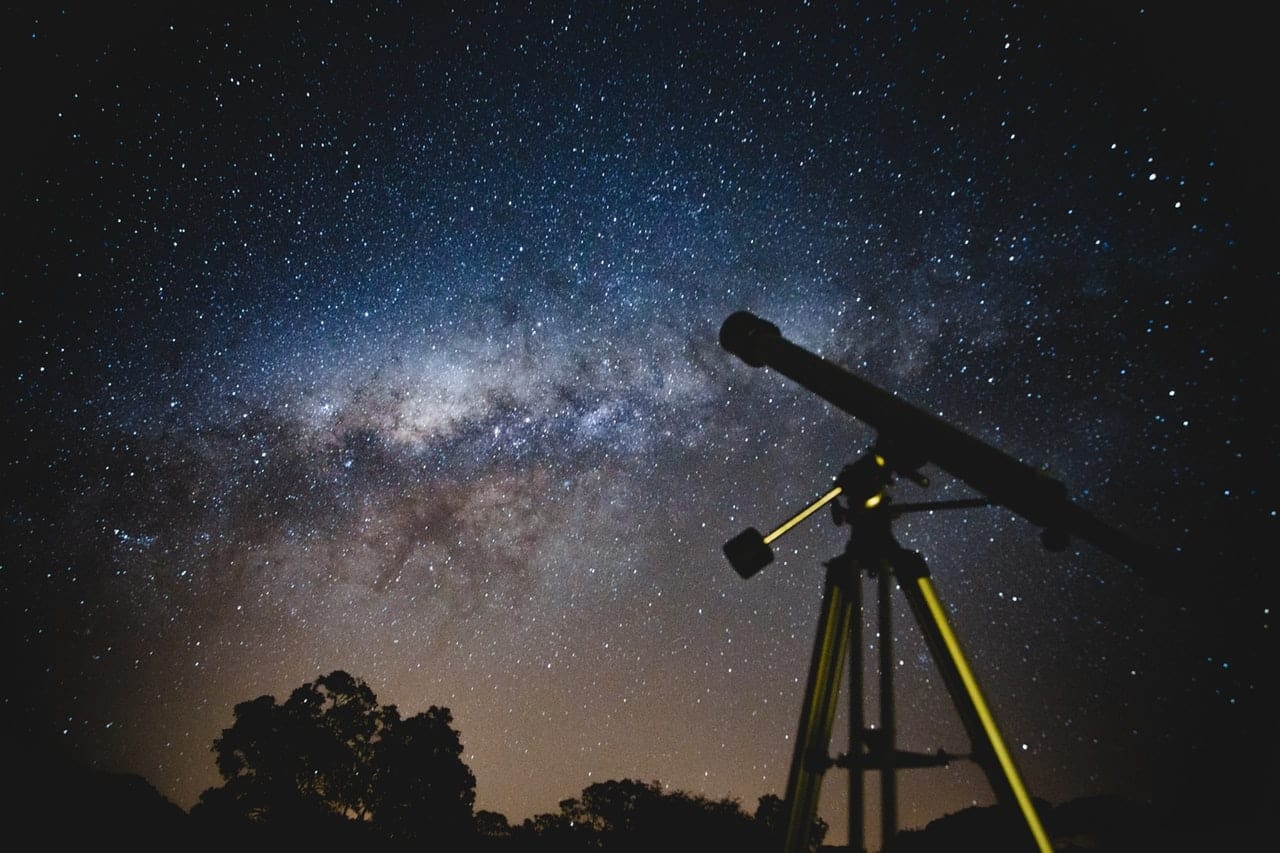
I know this might seem a little kooky or strange, but stick with me! You only need to make a quick search on Twitter or Instagram to see that astrology is huge at the moment. In fact, Pinterest’s recent trend report even mentioned that space and astrology are going to be significant trends in 2020.
With astrology so popular, it makes total sense to seize on the chance to use this in your campaigns. And with 12 different star signs, there’s the opportunity to target 12 different groups throughout the whole year.
Looking at Facebook Audience Insights, the group that shows the most interest in astrology is overwhelming women, who make up 65 percent of the worldwide audience. And, diving even more in-depth, we can see that women between 25-34 (31 percent) and 35-44 (20 percent) are particularly interested.
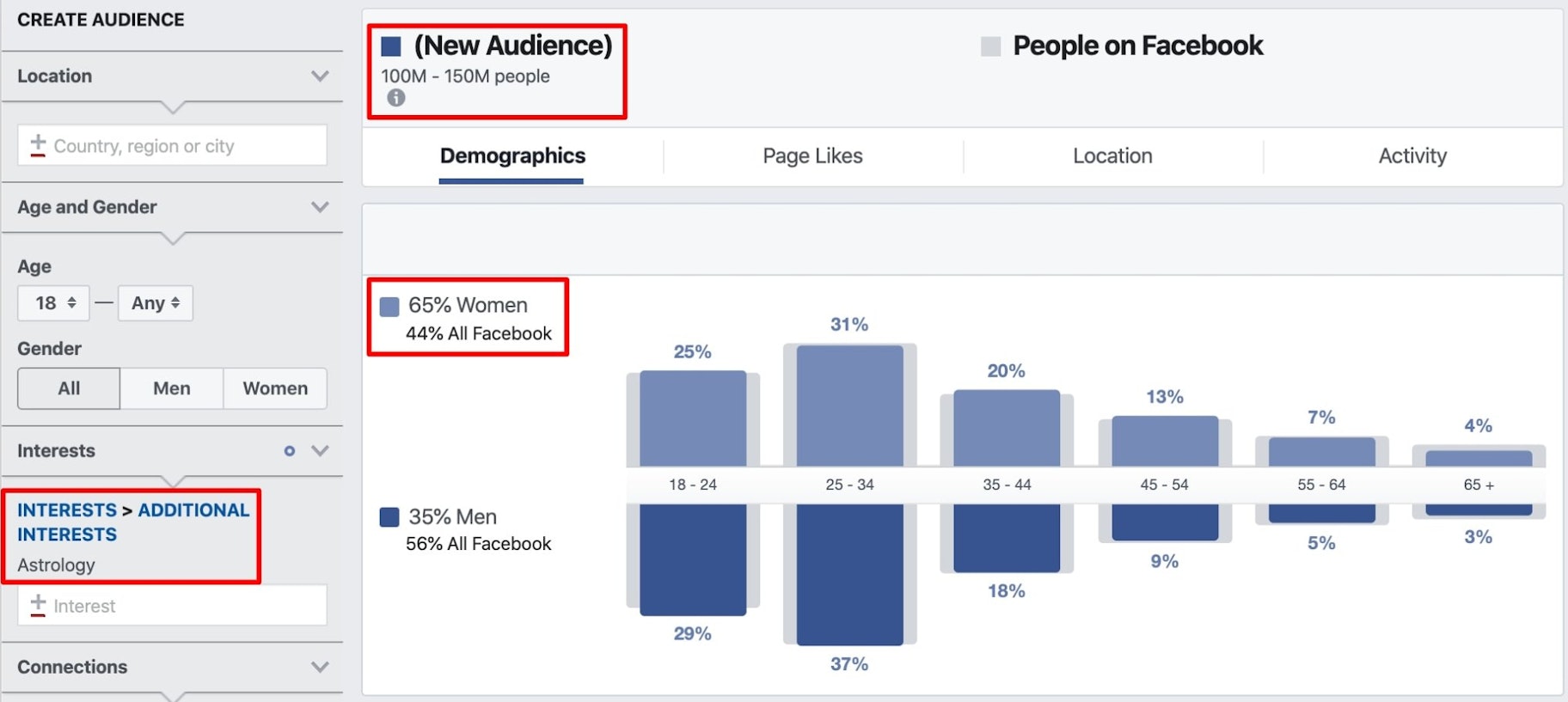
The best thing about using astrological signs as the basis for a campaign is that people who are interested in astrology love to feel as though they genuinely relate to their sign. You can use this to your advantage in the images and copy you use in your ads.
For example, Scorpios are often described as brave, passionate, and loyal, while Pisces are intuitive, gentle, and wise. Incorporating these traits into your ads could be a fantastic way to appeal to potential buyers even further.
And, because each astrological sign has a season of around 30 days, it gives you plenty of time to tinker with refining audiences, changing images, and copy to try and hook as many star sign enthusiasts as possible.
Seasonal Changes

Seasonal changes are a time of the year that businesses have been using in their sales campaigns forever, so really, you’d be silly not to use it as well.
No matter what you’re selling, there’s a way that you can tie your product to a seasonal sale – even if it’s something as the classic “the temperature is dropping, and so are our prices!”
You could even make it as simple as promoting free shipping for a season; this is ideal for a store selling more seasonal products like bikinis, Halloween costumes, or outdoor sportswear. Or why not add new products to that perfectly complement the season.
However, seasonal sales come with a few things to think about, for example, targeting northern and southern hemisphere countries for different seasons. After all, there’s no point advertising summer sales to Australians in June or July when they’re in the middle of winter.
It could also be worth researching when certain countries consider the season to have changed. For many countries, the seasons change on equinoxes and solstices – around the 20th of March, June, September, and December. However, Australia and New Zealand prefer to use meteorological seasons, so seasons begin on the 1st of March, June, September, and December. It’s a small detail, but it’s worth considering all the same.
Sporting Events
Everyone knows majoring sports events are big business, so why not try to grab some of that business for yourself by running campaigns during some of the notable competitions in 2020.
Below we’ve named some of the bigger tournaments and games planned for 2020, but don’t limit yourself to the ones we’ve listed. Different sports are popular in different parts of the world, so depending on the countries you’re targeting, you could find a whole different event that would be perfect to base a campaign around.
Tokyo Olympics

The Olympic games will captivate the world for more than two weeks this year as elite athletes descend on Tokyo to show off their skills. While the Olympics will officially run from July 24 until August 9, the hype will start weeks before the event, so it gives you plenty of time to run a campaign.
Because the summer Olympics only come around every four years, this allows you to run campaigns that bounce off this idea. For example, you could create gigantic “once in four years” discounts, or promise free shipping for the duration of the games.
Or, why not get super savvy and offer discounts based on the results of athletes or sports teams. Perhaps you could offer 1 percent off for each gold medal a country adds to their medal count – all it takes is some discount codes and geo-targeting to make this super-localized campaign a reality.
Superbowl LIV
The Superbowl has become so massive in recent years that it’s no longer just a big deal in the United States, it’s very much a worldwide event.
The Superbowl is an incredibly commercial competition, with advertising airtime worth millions for mere seconds. Luckily it won’t cost you quite as much to run a Superbowl-centric ad, but you could score big.
A flash sale for Superbowl day could be a fantastic way to catch the eye of potential customers, or why not target fans of the two teams playing and offer special discount codes.
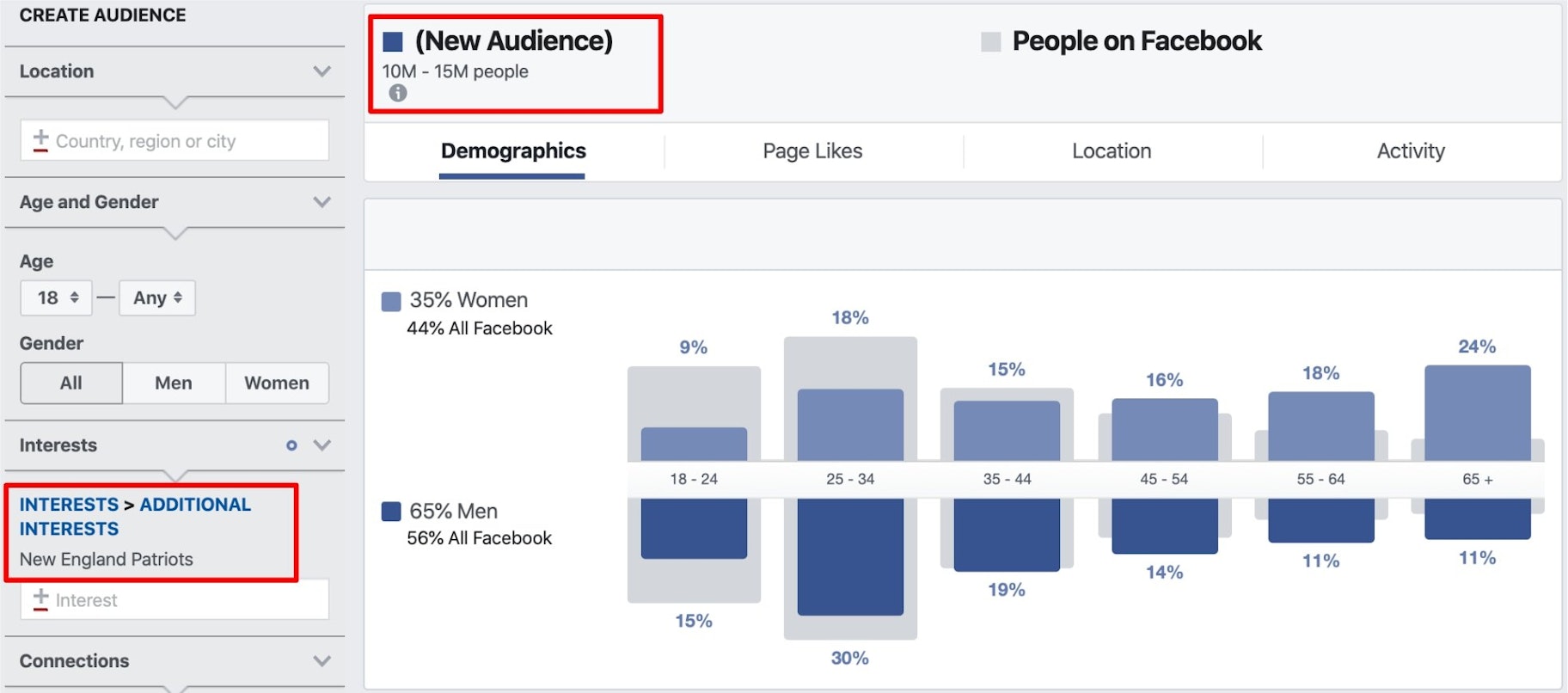
And depending on the products you sell, you could even start advertising well before the big game. For example, if your store has food or kitchen-related items, why not try and sell these items the month before the game, pitching them as the ideal products for a Superbowl party.
Euro 2020
From one ball sport to another, the European football championship is also happening in 2020 in a tournament that will last from June 12 to July 12.
With 12 countries competing in this event, it offers anyone targeting European countries the opportunity to create localized ads and woo customers. Or, if you’d prefer not to have to translate your ads into different languages, focus on advertising to the younger demographic who are more likely to speak English.
Cultural Events

If your store or products don’t exactly chime with sporting events, perhaps something in the cultural sphere could be more suited.
This is a vast category, and I’ve used it to encompass things like entertainment, art, and music. But, as with sport, don’t take this list as an exhaustive one – there are thousands more big events out there. And, perhaps even more so than sports, there will be cultural events that are huge news in some countries but might be relatively unheard of on an international scale.
That said, as always, some things definitely have worldwide appeal, and you can very much use this to your advantage in your campaigns.
Awards Season
The glitz and glamor of awards season kicks off in January with the Golden Globes, Grammys, Academy Awards, and BAFTAs, to name just a few.
If your store is related to entertainment, clothing, or jewelry, this could be the perfect time to target audiences already focussed on who’s attending the ceremonies and what they’re wearing.
San Diego Comic-Con

From July 23-26, over 130,000 people descend on the San Diego Convention Center to hear from their favorite TV and movie stars and to watch much-anticipated trailers for the first time.
And aside from the thousands who gather in San Diego, millions more all over the world who follow the event on Facebook, Twitter, Instagram, and Youtube, waiting for exclusive SDCC footage and interviews to be released.
If you sell items that are in any way related to fandoms or entertainment – projectors, wigs, costumes, accessories – comic con is the time to target these fans.
TV Series, Game, and Movie Releases
Piggybacking off of Comic-Con, TV, game, and movie releases are also great times for sales – especially for niche stores.
If you sell products that complement TV shows – for instance, medieval-themed items work well with shows like The Witcher or Vikings – then be sure to keep track of when those series return.
You can also think about when trailers are released, when finales are scheduled, and when major plot points might send fans racing to the internet. These are all the perfect times for you to advertise your store.
Music Festivals
Festivals and concerts are incredibly location-dependent, but they can be smart to target if your store has items that would appeal to the festival-going crowd. Think jewelry, clothing, bags, sunglasses, and other accessories.
Depending on the countries you’re targeting, you could advertise to the enormous crowds headed to mega-festivals like Coachella, Burning Man, or Glastonbury. Or maybe do some more research on festivals that are more locally known.
Festivals aren’t cheap to attend, and most festival-goers will spend time planning their trip ahead of time. This gives you the chance to start advertising from the time of lineup announcements and early ticket sales.
Wrapping Up and Things to Keep in Mind
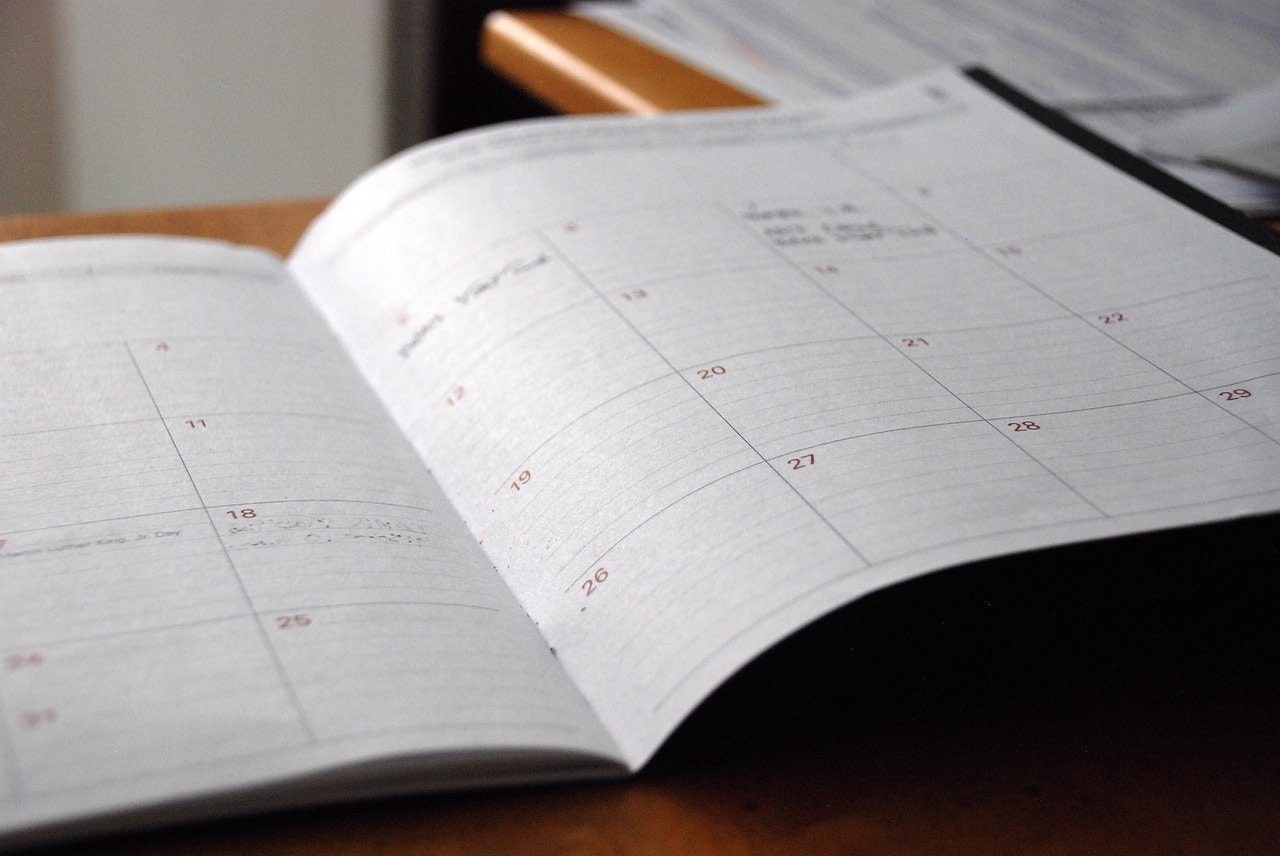
So there you have some of the biggest events and dates in 2020 that you could potentially use in your ads and campaigns.
However, this is only a starting point, there is so much more happening than what is listed here, and that’s important to bear in mind when you plan your big sales in 2020.
Find Your Opportunities
Even though we’ve covered a lot of holidays, dates, and events, there will undoubtedly be a ton more that we could never predict, but would be great for campaigns – this is especially true for stores that sell very niche products. However, staying alert and seizing the opportunities when you see them will help.
For example, if you enjoy the internet and pop culture, don’t be afraid to jump on trends or memes and use them in ads. While you can’t necessarily foresee what will become popular, if you’re willing to try new ads when you notice trends, it could yield significant returns.
It could be something as simple as a word or phrase (think 2019’s “OK boomer” or the evolution of DoggoLingo) or a suitable meme format. Whatever it is, if it’s relevant to your products, why not try it out in an ad.
Don’t Try and Force Something If It Doesn’t Fit
Before you go off and start planning your ecommerce campaigns for 2020, staying mindful of your audience and product is critical.
While it might be tempting to try and take advantage of certain days or events with sales and marketing, if it doesn’t fit with your products, then don’t try to force it. If you’re struggling to connect your items with the day, then your customers probably will too, and you’ll lose the wow factor in your campaign. Besides, with so many days out there, you’re bound to find some super relevant ones – concentrate on making those great.
Design Your 2020 Calendar
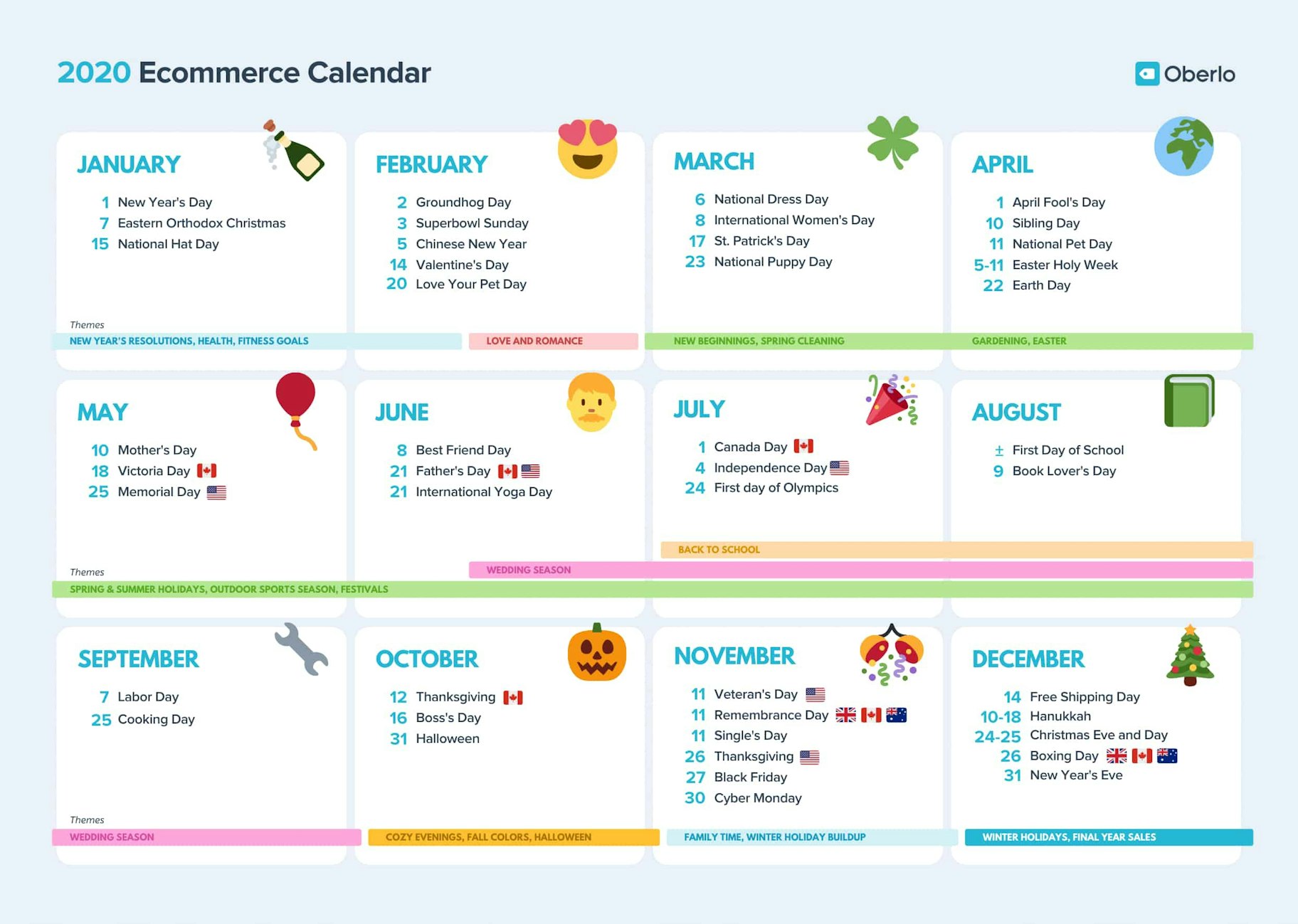
With all the inspiration on this list, you’re probably bursting with plenty of campaign ideas for your store. Take the opportunity to download our 2020 ecommerce calendar to help you remember some of the more significant dates as well as adding your store-relevant dates. We recommend printing it off and keeping it nearby so you have it for reference for the whole year.
What events are you planning to incorporate into your advertising, and why? Tell us in the comments below.



